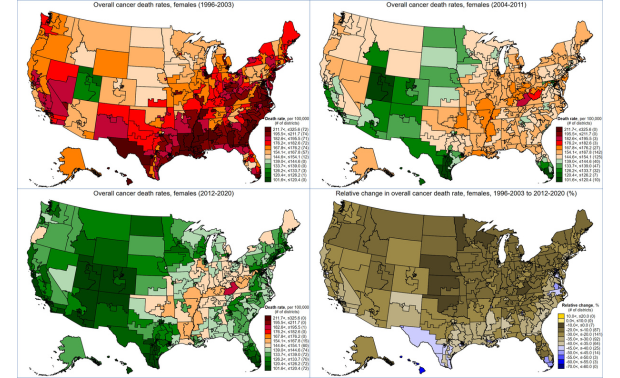ACS researchers stress interventions to reduce cancer risk factors and improve access to cancer screening and treatment.
In the first analysis of its kind, ACS researchers discovered cancer death rates across all congressional districts in the United States show an overall decline in the past 25 years, with most districts showing a 20%-45% decline among males and a 10%-40% decline among females. The highest declines were found in districts along the southern coast and border and the smallest declines were in the Midwest and central parts of the South, including Appalachia. The data also showed disparities in cancer death rates based on race and ethnicity. The study was published recently in the journal Cancer.
“The good news is overall cancer death rates declined for both men and women in all congressional districts,” said Dr. Farhad Islami, ACS senior scientific director, cancer disparity research and lead author of the study. “However, we saw substantial disparities in progress against cancer mortality across congressional districts. Moreover, while the decline in death rates from cancer was most pronounced for Black men, overall cancer mortality remains substantially higher among Black people compared to other populations. We also found the number of districts with the greatest relative declines in overall cancer death rates was larger among Hispanic people than white people. But paradoxically, Hispanic people also had the largest number of districts with no or smallest relative declines in rates.”
This is the first published study examining disparities in reducing cancer death rates by congressional district and provides data for four common causes of cancer death and by race/ethnicity. Data was broken down by the four most common cancer types and researchers reported the following:
- Lung cancer – The biggest reduction in death rates due to lung cancer were among males across all congressional districts, with declines ranging from 21%-72% since 1996. Districts in the Midwest and South, regions with generally weaker tobacco control policies, saw the smallest declines among both sexes and while women’s deaths from lung cancer had previously been scattered across the U.S., in the latest data, the highest lung cancer deaths in both sexes are clustered in the Midwest and South.
- Colorectal cancer – Historically, death rates from colorectal cancer were generally scattered in the Northeast, South, and lower Midwest. A shift has taken place over the past 25 years and now the districts with the highest colorectal cancer death rates are found around the Mississippi River Valley in the South and in Appalachia.
- Female breast cancer – Across the country, death rates from female breast cancer dropped by anywhere from 13.6% to 57.7%. The congressional districts which had previously had the highest death rates -- along the East Coast and southern U.S. border -- saw the largest reduction in deaths and now districts in the South and East North-Central section of the Midwest see higher death rates.
- Prostate cancer – Again, the districts which had previously seen the highest death rates from prostate cancer – those along the East Coast and in the South – saw the largest drops in the latest data. Relative declines across the U.S. ranged from 25% to more than 68% in some areas. Currently, districts with the highest death rates are concentrated in the South and West.
Other ACS authors participating in this study include: Dr. Daniel Wiese, Dr. Emily C. Marlow, Tyler B. Kratzer, Jason Massey, Dr. Hyuna Sung, and Dr. Ahmedin Jemal.


